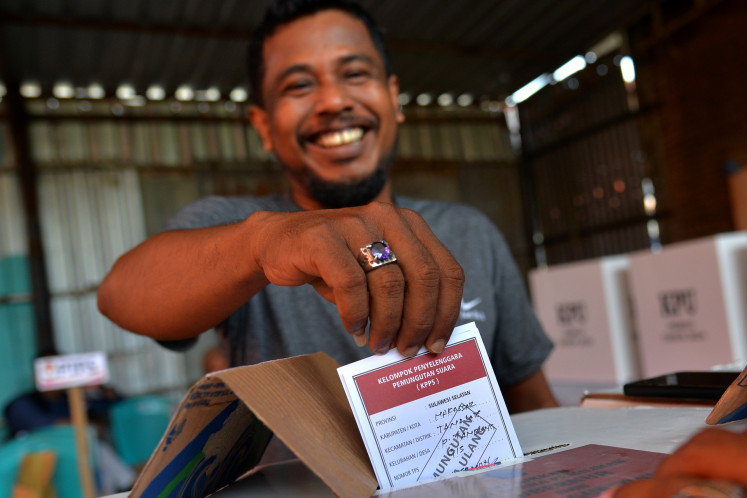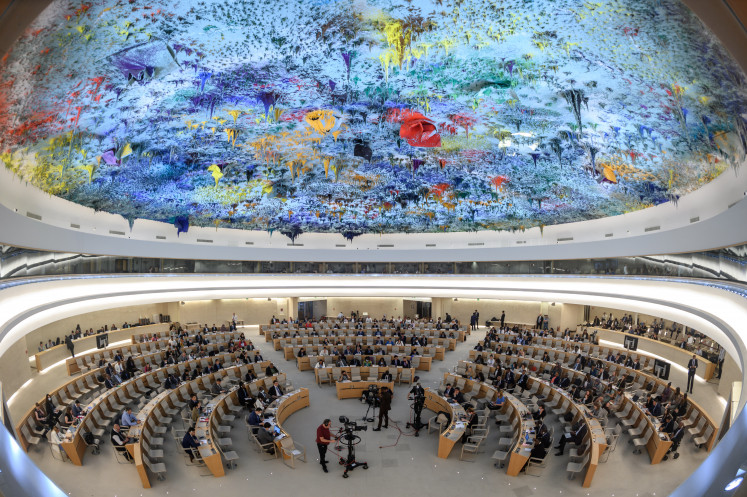Popular Reads
Top Results
Can't find what you're looking for?
View all search resultsPopular Reads
Top Results
Can't find what you're looking for?
View all search resultsKuta: From a hippy gem to an overcrowded tourist strip
Rebound: Tourists pass Jl
Change text size
Gift Premium Articles
to Anyone
R
span class="caption">Rebound: Tourists pass Jl. Legian on the Kuta tourist strip, which reeled after 202 people died in the bombings in 2002. The isle’s second terror attack, in 005, further devastated the island’s tourism-dependent economy. Today, Bali’s young people are now turning to creative industries to make their ivelihoods. (JP/Agung Parameswara)
At the turn of the 1960s–‘70s, 17-year-old I Made Wendra would see American hippies camping on Kuta’s white sandy beaches.
At the time there were no hotels in Kuta, apart from the big government-owned Grand Inna hotel, according to Wendra.
The hotel was only accessible to those who had the money to afford to stay there, so the rest (and the more adventurous traveler) had to be content with tents.
However, there was one facility the campers lacked, which was a bathroom, and they did not want to defecate on the beach.
“They had to go to the villagers’ houses, so that’s how we first began contact with tourists,” Wendra said. “But we didn’t have toilets either! The visitors told us that we should make toilets and that we should rent out places for them and that was the start of it,” Wendra said. His family would rent out their house to tourists and Wendra experienced nights sleeping on the kitchen floor.
While it was nature’s call that made tourists connect with the villagers, the flocking of tourists to Kuta, which transformed the area into a bustling tourist enclave by 1990s, was mostly down to word of mouth, he said.
Wendra witnessed Kuta’s transformation from a sleepy village into the mass tourist center that it is today. When terrorists hit Bali on Oct. 12, 2002 with the bombing at the Sari club on Jl. Legian, he was the customary village leader in Kuta.
The attack was only a short walk away from his lodgings at the Aquarius Hotel, and so he was among the first who helped victims of the attack.
The attack in 2002 and again in 2005 wrecked Bali’s heavily tourism-dependent economy. “Kuta experienced the biggest hit,” Wendra said.
After each bombing, it took around one year to recover. Ten years after the first attack, Kuta is the bustling area it was before and more. But there is the feeling of a good thing gone sour.
Traffic jams frequent the narrow Legian road up to the wee morning hours. In what was once a place famous for its small budget hotels, huge high rise developments have joined the crowd.
Former Kuta head district I Gusti Adnya Subrata who was in office during the Bali bombing tragedy said that Kuta developed “too soon” and the government attempted to manage it “too late”.
“Kuta’s growth was unplanned. It grew by itself and the local government was too late in setting up infrastructure,” Subrata said. Unlike the resort area developed by the government — Nusa Dua, in the most sourthern part of Bali, which is equipped with large roads and adequate pedestrian paths — Kuta developed organically.
Families of locals such as Wendra, Subrata and Supatra Karang (owner of Mimpi bungalows and initiator of Kuta Carnival) started to build accommodation between Kuta’s narrow roads. This also attracted investors from outside Bali who followed the wave of Kuta’s increasing popularity and opened hotels, bars and restaurants to get a slice of the tourism pie. Subrata said despite its chaos, people were drawn to Kuta because they could interact with the local Balinese. “Which is different to Nusa Dua,” he said.
Kuta’s regency, Badung, has the highest increase of hotel rooms in the whole island. Badung, which consists of Kuta, Seminyak, Canggu, Nusa and Jimbaran, had more than 78,000 rooms in June 2012. Over a decade ago the area only had less than half of that number with nearly 37,000 rooms in 2001, according to the Association of Indonesian Hotels and Restaurants (PHRI).
Karang, who initiated the annual Kuta Carnival to revive tourism in the area, said that there is now an urgent environmental problem to tackle in Kuta aside from the traffic jams.
Groundwater exploitation due to mass tourism will lead Kuta to a water crisis, he said. This had been predicted nearly two decades before in 1997 by the Environment Ministry. The ministry predicted that the island would experience a water deficit of up to 27 billion liters by next year.
Bali Governor Made Mangku Pastika last year initiated a moratorium for hotel development in the southern part of Bali — Badung, Denpasar and Gianyar — but regional leaders have refused to commit to it. Badung Regent AA Gede Agung said that his regency still welcomed hotel investment projects.
The only place that is off-limits to hotel investment projects is the area where Sari club once stood. Across from the bomb memorial on Jl. Legian, the plot of land is an abandoned vacant lot. Pastika and the Australian government want to develop the place into a memorial park for the bomb victims. Plans for this are stifled because the owner, who lives in Jakarta, is asking for a “crazy” price, Pastika said. For now, this plot of land at least is free from new development.
— JP/Prodita Sabarini










